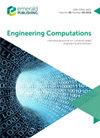利用五次 B-样条拟合法模拟地下水流与污染物迁移的耦合过程
IF 1.5
4区 工程技术
Q3 COMPUTER SCIENCE, INTERDISCIPLINARY APPLICATIONS
引用次数: 0
摘要
本研究的目的是针对规则和不规则几何形状的二维耦合地下水流动和输运模拟问题,引入一种无稳定性条件和高阶精度的新数值方案,并将其结果与模块化三维有限差分地下水流模型(MODFLOW)和模块化三维多物种输运模型(MT3DMS)等广为接受的程序进行比较。在空间中使用 Quintic B-spline (QBS) 函数转换偏微分方程,以表示常微分方程系统中的相关物理现象。然后使用 DOPRI5 算法求解该系统,该算法无需稳定性条件。结果表明,所提出的数值方案可以成功模拟几何和参数结构复杂的二维耦合地下水流和输运问题。原创性/价值 据作者所知,QBS-DOPRI5 方法是首次用于解决具有复杂几何结构的二维耦合地下水流动和输运问题,并可扩展到高维问题。未来,考虑到所提出的数值方案的成功,该方案可成功用于地下水污染源特征识别。本文章由计算机程序翻译,如有差异,请以英文原文为准。
Simulation of coupled groundwater flow and contaminant transport using quintic B-spline collocation method
PurposeThe purpose of this study is to introduce a new numerical scheme with no stability condition and high-order accuracy for the solution of two-dimensional coupled groundwater flow and transport simulation problems with regular and irregular geometries and compare the results with widely acceptable programs such as Modular Three-Dimensional Finite-Difference Ground-Water Flow Model (MODFLOW) and Modular Three-Dimensional Multispecies Transport Model (MT3DMS).Design/methodology/approachThe newly proposed numerical scheme is based on the method of lines (MOL) approach and uses high-order approximations both in space and time. Quintic B-spline (QBS) functions are used in space to transform partial differential equations, representing the relevant physical phenomena in the system of ordinary differential equations. Then this system is solved with the DOPRI5 algorithm that requires no stability condition. The obtained results are compared with the results of the MODFLOW and MT3DMS programs to verify the accuracy of the proposed scheme.FindingsThe results indicate that the proposed numerical scheme can successfully simulate the two-dimensional coupled groundwater flow and transport problems with complex geometry and parameter structures. All the results are in good agreement with the reference solutions.Originality/valueTo the best of the authors' knowledge, the QBS-DOPRI5 method is used for the first time for solving two-dimensional coupled groundwater flow and transport problems with complex geometries and can be extended to high-dimensional problems. In the future, considering the success of the proposed numerical scheme, it can be used successfully for the identification of groundwater contaminant source characteristics.
求助全文
通过发布文献求助,成功后即可免费获取论文全文。
去求助
来源期刊

Engineering Computations
工程技术-工程:综合
CiteScore
3.40
自引率
6.20%
发文量
61
审稿时长
5 months
期刊介绍:
The journal presents its readers with broad coverage across all branches of engineering and science of the latest development and application of new solution algorithms, innovative numerical methods and/or solution techniques directed at the utilization of computational methods in engineering analysis, engineering design and practice.
For more information visit: http://www.emeraldgrouppublishing.com/ec.htm
 求助内容:
求助内容: 应助结果提醒方式:
应助结果提醒方式:


